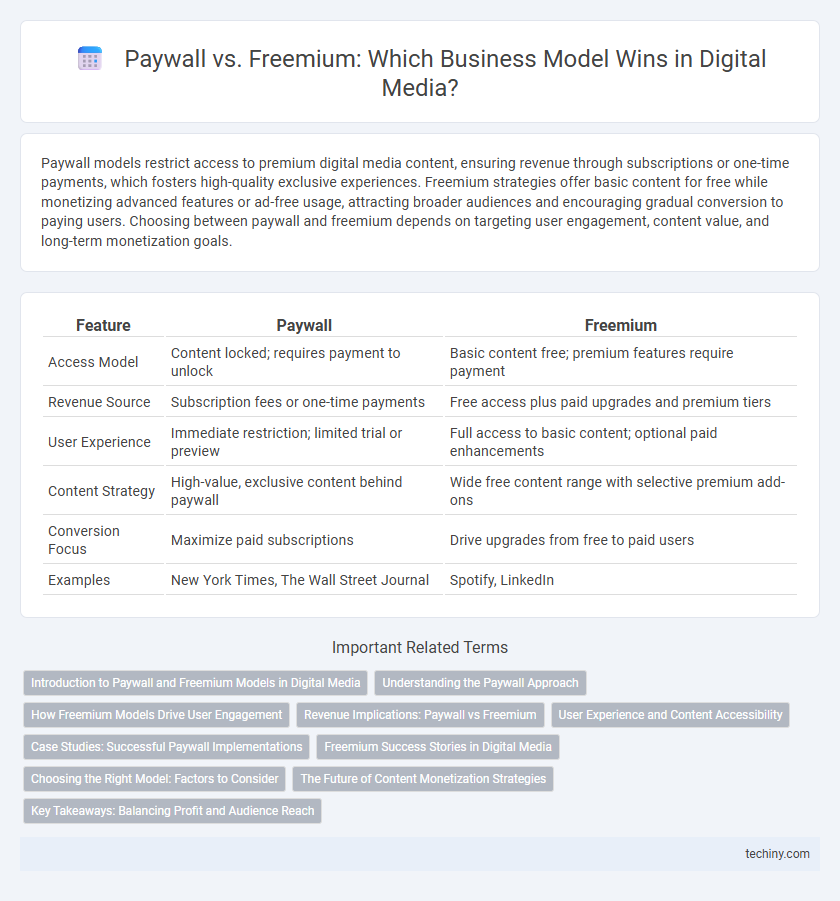Paywall models restrict access to premium digital media content, ensuring revenue through subscriptions or one-time payments, which fosters high-quality exclusive experiences. Freemium strategies offer basic content for free while monetizing advanced features or ad-free usage, attracting broader audiences and encouraging gradual conversion to paying users. Choosing between paywall and freemium depends on targeting user engagement, content value, and long-term monetization goals.
Table of Comparison
| Feature | Paywall | Freemium |
|---|---|---|
| Access Model | Content locked; requires payment to unlock | Basic content free; premium features require payment |
| Revenue Source | Subscription fees or one-time payments | Free access plus paid upgrades and premium tiers |
| User Experience | Immediate restriction; limited trial or preview | Full access to basic content; optional paid enhancements |
| Content Strategy | High-value, exclusive content behind paywall | Wide free content range with selective premium add-ons |
| Conversion Focus | Maximize paid subscriptions | Drive upgrades from free to paid users |
| Examples | New York Times, The Wall Street Journal | Spotify, LinkedIn |
Introduction to Paywall and Freemium Models in Digital Media
Paywall models restrict access to digital media content by requiring users to pay for full or partial access, often through subscriptions, enhancing revenue generation for publishers. Freemium models offer basic content for free while charging for premium features or exclusive content, driving user acquisition and conversion. Both strategies balance content accessibility and monetization, adapting to changing consumer behaviors in digital media consumption.
Understanding the Paywall Approach
The paywall approach in digital media restricts access to premium content by requiring users to pay for subscriptions or one-time access, maximizing revenue from loyal audiences and reducing dependence on advertising. Unlike freemium models, paywalls offer exclusive, high-value content behind a barrier, encouraging consistent user commitment and higher retention rates. Implementing metered or hard paywalls allows publishers to balance free sampling with monetization strategies, optimizing both audience growth and income generation.
How Freemium Models Drive User Engagement
Freemium models drive user engagement by offering essential content for free while reserving premium features or exclusive content behind a paywall, encouraging users to explore and invest gradually. This approach increases user retention through continual interaction and provides ample opportunities for upselling subscriptions or one-time purchases. Data shows freemium users convert to paying customers at higher rates when they experience value firsthand before committing financially.
Revenue Implications: Paywall vs Freemium
Paywall models generate predictable revenue by restricting content access to paying subscribers, often leading to higher average revenue per user (ARPU) but potentially limiting audience reach. Freemium strategies attract a larger user base by offering free content with optional premium upgrades, which can drive revenue through volume and upselling but may result in lower immediate ARPU. Balancing these models requires analyzing conversion rates, customer lifetime value (CLV), and market segmentation to optimize overall digital media revenue streams.
User Experience and Content Accessibility
Paywall restricts access to premium digital media content unless users subscribe, ensuring exclusive, high-quality material but potentially limiting casual readership and content discoverability. Freemium models offer a blend of free access with optional paid upgrades, enhancing user experience by allowing content sampling while encouraging conversion through added features or ad-free options. Balancing accessibility and monetization, freemium often fosters higher engagement and broader audience reach compared to strict paywalls.
Case Studies: Successful Paywall Implementations
The New York Times saw a 72% increase in digital subscriptions after implementing a flexible metered paywall, demonstrating the effectiveness of controlled content access. The Financial Times employed a hard paywall with premium content, resulting in a 25% revenue growth within a year due to high-value, exclusive articles. Conde Nast leveraged a hybrid freemium model, balancing free access with premium features, which boosted user engagement by 40% and increased conversion rates significantly.
Freemium Success Stories in Digital Media
Freemium models have driven significant user growth and revenue in digital media, with Spotify and LinkedIn exemplifying success by offering free access to core features while monetizing premium subscriptions. Spotify's freemium approach attracts millions of users with ad-supported streaming, converting a substantial portion to paid plans for enhanced experiences. LinkedIn leverages freemium by providing free networking tools alongside premium memberships that unlock advanced job search and recruitment capabilities, fueling strong engagement and profitability.
Choosing the Right Model: Factors to Consider
Selecting between a paywall and a freemium model in digital media depends on audience behavior, content value, and revenue goals. Paywalls suit premium, exclusive content with a loyal user base willing to pay, while freemium attracts broader audiences by offering free basic access and monetizing advanced features. Consider factors like user engagement data, content uniqueness, and long-term subscription potential to maximize profitability and audience retention.
The Future of Content Monetization Strategies
Paywall and freemium models are evolving as pivotal strategies in digital media for content monetization, with subscription growth and user engagement as key metrics for success. Data indicates that hybrid approaches combining limited free access with premium paid tiers drive higher conversion rates and sustain revenue streams. Advances in AI-driven personalization further refine paywall implementations, optimizing content delivery to maximize user retention and profitability.
Key Takeaways: Balancing Profit and Audience Reach
Paywall models generate consistent revenue by restricting content access, ensuring higher customer lifetime value but may limit audience growth and engagement. Freemium strategies attract broader audiences through free content while converting a fraction into paying subscribers via premium features, balancing reach and profitability. Effective digital media strategies combine data-driven segmentation with adaptive pricing to optimize both user acquisition and sustainable revenue streams.
Paywall vs Freemium Infographic

 techiny.com
techiny.com